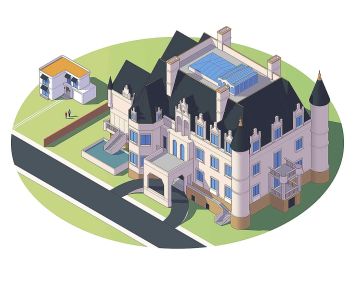Is Biodiversity The Next Big Thing in Sustainable Real Estate Development?
By Logan Nagel February 7, 2024 11:14 am
reprints
The Rancho Mission Viejo community in Orange County, Calif., dedicated around 75 percent of the site’s 23,000 acres as a nature reserve. The move by the builders of what’s billed as California’s largest new community, with some 35,000 anticipated residents in 14,000 homes surrounded by retail and other commercial space, not only provided a major sales draw — it also satisfied local wildfire resiliency requirements.
Call it an example of the stars aligning for conservation goals and financial investment. While the U.S. real estate industry has yet to get behind such biodiversity at a level similar to its push on decarbonization, future government mandates may change that.
Real estate-related conservation win-wins like the one in Orange County are a global ray of sunshine for the million species at risk of extinction, primarily due to habitat loss. The biggest win yet in recent times might have been last month in the United Kingdom, where a new regulation takes effect promoting biodiversity net gain, not just impact reduction, at development sites.
According to the regulation, large real estate development projects are now required to deliver a 10 percent net gain to biodiversity, calculated via a measurement framework that accounts for the size, quality and specifics of the natural habitat at the construction site. It also goes a step further by permitting biodiversity offsets elsewhere only if regenerating on-site habitats is not feasible. The change could spur innovative approaches to development as well as an emergent market for biodiversity credits, like carbon credits before them.
There’s a reason the U.K. regulation focuses on new development. “It doesn’t take a whole lot of time to degrade a habitat,” said Eyal Frank, an environmental economist and assistant professor at the University of Chicago. “It might take a very long time to restore it to its baseline level.”
Stopping disruption before it can happen is the most effective way to limit habitat degradation, and consequently species loss.
Assessing biodiversity in real estate
Emphasizing biodiversity mirrors another sustainability cause already seeing plenty of movement: the decarbonization of buildings. In that case, a combination of regulations, incentives and demand from investors and occupiers led landlords to adopt new technologies and sustainable material choices.
There are differences from the decarbonization push, though. The impacts of carbon emissions are global in scope, while biodiversity is largely a local challenge. Property development that disrupts natural habitat can jeopardize the security of numerous species by taking up space and breaking down food chains. As different types of plant and animal life die off, biodiversity drops. The real estate business impacts biodiversity through three core pathways, according to the Urban Land Institute (ULI): land use change, sourcing of unsustainable materials and climate change. While that third one is addressed by the wave of improvements to building energy performance, the other two still require their own solutions. So where will the impetus come from?
Proponents of biodiversity preservation or restoration point to several benefits of their efforts. ULI recently released an in-depth report on nature-positive and pro-biodiversity real estate, which describes numerous business cases for investment in nature-
positive solutions: compliance with regulation, as in the U.K.; enhancements to property value; opportunities to make on-site improvements at low cost, such as native plants that reduce landscaping and water use; community engagement wins; interest from stakeholders such as investors; benefits to climate resilience; compliance with disclosure standards; and achievement of various building certifications such as LEED or WELL.
It’s the regulation angle that may spur effort the fastest.
According to Andrew Bush, principal of sustainability-focused developer Morgan Creek Ventures, tenants may not provide the pressure needed to get biodiversity-centric real estate off the ground. “It will be probably quite a while before tenants look at biodiversity as part of their leasing decisions,” Bush said. “I think it’s more likely to come from a regulatory framework. … And I think that biodiversity is young, it’s a young science, and it’s young politically in terms of discussions.”
On the residential side, Jameson Hartman, vice president at proptech venture capital investor RET Ventures, shared a similar perspective. “If a resident knows that there are 100 different species of plant on the property, does that change the outcome versus, ‘We know we have two or three tree types and we have four or five plants’? That’s the only tough part.”
A regulatory framework like the one in the U.K., relying on a standardized scoring system and specific carrots and sticks, could provide the kind of top-down mandate to get new construction on the track toward biodiversity. A few U.S. cities have already gone down this road. The ULI report points to Seattle’s Green Factor and Washington, D.C.’s Green Area Ratio, but these focus on landscaping and don’t emphasize ecology or biodiversity. Prioritizing such an approach would come with substantial challenges.
Measurement challenges
Unlike measuring the carbon emissions of a building or the embodied carbon within its walls and floors, which are comparatively straightforward numeric values, it is difficult to develop a standardized system of values, impacts and relationships for biodiversity. Species occupy complex, inter-reliant networks, and what’s good for one species might not be good for another.
In the United Kingdom, where the biodiversity net gain regulation recently went into effect, assessment of disruption is made according to a complex rubric that takes into consideration what sort of habitat has been impacted and whether it is a particularly irreplaceable ecosystem, such as a part of an ancient forest.
It may take a concerted push by a major industry organization to lead the charge, Bush said.
“I think LEED did a lot of good to educate a lot of people as to what was possible at different levels,” he said of building sustainability.
As for biodiversity in development, a clear cheerleader has yet to emerge
“Who’s going to develop the ecological framework for real estate and real estate development on the biodiversity side?” Bush said. “Who will that come out of, to take something that can be quantified and measured so you can calculate an impact fee or something?”
This complexity makes setting up any type of consistent measurement scheme challenging.
The Inflation Reduction Act, the 2021 federal law that made funds available for a range of projects from clean energy investment to energy efficiency home improvements, might serve as a rubric for mandates that spur biodiversity investment.
“I think the local level will probably define what specifically needs to be, and probably funding could come from a federal level,” Hartman said. “I wouldn’t be surprised if that’s the case.”
Beyond the challenge of setting up a framework for assessment, pushing biodiversity goals may lead to friction with other green objectives.
“In cities like Chicago that have done green roof ordinances, oftentimes they compete for solar space,” Bush said. “You kind of have to decide what’s the most important thing to do with that specific piece of real estate, being the roof in this case.”
A focus on biodiversity might be a logical next step in the pathway of sustainable real estate after the current focus on energy efficiency. “It took us a decade to bring operational carbon and all-electric buildings to the forefront,” Bush said. “I think it’s going to take us another decade to really bring embodied energy [the total energy needed to create a given product or service] to the forefront. I would guess that biodiversity either works in lockstep with embodied energy or follows the path of embodied energy.”
The tech angle
Where private property owners may hesitate before investing in biodiversity solutions, government-owned property may represent a compelling market for providers. The government’s property footprint and land holdings could represent an area where biodiversity tech providers may see their first real market.
“We’re seeing an influx of consumer demand for the national parks,” Hartman said. With more visitors, agencies may need to rely on tech solutions to pre-empt or offset human disruption. “That’s probably where I see the easiest sales cycle for somebody to come in.”
Whether that’s solving for existing ecosystem disruption or mitigating ongoing impacts, he added, there’s a big opportunity for biodiversity solutions providers in this niche.
Beyond that, Hartman encouraged biodiversity tech providers in the real estate space to emphasize property outcomes and bottom-
line impacts first and foremost. “There’s not a lot of benefit to being a first mover as a real estate owner. [Owners want to] be the second mover and say ‘OK, well, this technology has been adopted, this technology is valid. It does improve our bottom line, it does benefit the environment.’ ”
While there’s a sense that on-site is best when it comes to energy generation, Bush said threats to biodiversity occupy larger scales than just the property area itself.
“That’s where I’m intrigued to see where biodiversity thinking goes, breaking things down into urban, suburban, rural, and then thinking about the larger ecosystems that cities and our projects are part of. And I think that’ll be really fun.”


